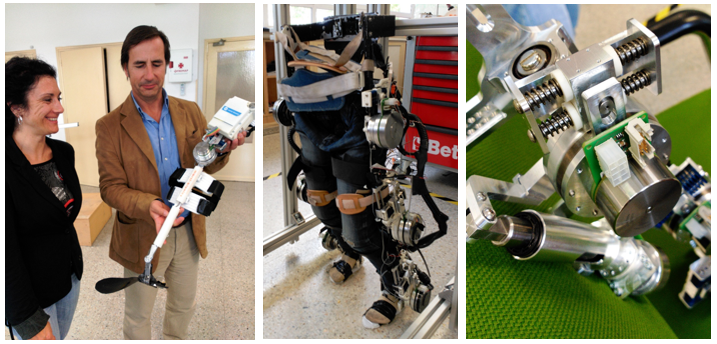A Wearable Robot (WR) is a kind of machine placed in close fit with the human body, thereby moving in synchrony with its limbs. The most common Wearable Robots are Exosuits and Exoskeletons. There are several practical applications that include assistance of elderly or disabled people as well as human performance augmentation for heavy-duty workers and military applications.
The first time I saw an exoskeleton was on October 2004, when I attended the RoboNexus event at San José (California). Between other activities, they celebrated the Tetsujin contest where I saw several sort of exoskeletons, one of them able to lift more than 1.000 pounds. This was one of the sort of exoskeletons for human performance augmentation (EHPA), a mechatronic system placed in parallel to the operator’s body with the aim of increasing its strength [1].
Nevertheless, exoskeletons still present a number of ongoing challenges, including: 1) rigid links with pin joints resist the movement of the biological joints if they are not perfectly aligned and 2) exoskeletons require bulky self-aligning mechanisms [2].
Some years later, on 2007 I had the chance to meet Dr. Yoshiyuki Sankai, CEO at Cyberdyne Inc. from Japan, with whom I had a nice talk about the future of the exoskeletons, exosuits and other technologies for performance augmentation and medical applications. In that moment Cyberdyne Inc. had just 3 years. Now after more than 11 years is possibly the most advanced company manufacturing exoskeletons applications in the world.
Left picture: Dr. Yoshiyuki Sankai and Alejandro Alonso-Puig. Right Picture: A Cyberdyne exoskeleton
On October 2015, I went to visit Marsi Bionics the Spanish Startup company created by my friend PHD. Elena García Armada, roboticist at the Centre for Automation and Robotics - joint centre by the Spanish National research Council (CSIC) and Universidad Politecnica de Madrid (UPM). I went to visit the company also with Melonee Wise (CEO at Fetch Robotics) and Angel Hernández (Fetch Robotics)
From left to right: Alejandro Alonso-Puig, Melonee Wise, Ángel Hernandez and Elena García
Marsi Bionics spun off from CSIC, devoted to contribute to restoring the quality of life of people suffering from locomotive disorders. With a multidisciplinary team of engineers, researchers and medical professionals, the company works in developing bionic exoskeletons for locomotion assistance, mainly for children.
Some statistics: 1% of the world population have walking disabilities. From them, 4% are adults with spinal cord injuries, 5% are children with neuromuscular diseases, 12% are children with cerebral palsy and spina bifida. The rest are elderly. About 18 million children cannot walk [3].
But the problem is not only this. The side effects of losing walking ability during a long time are malformations, scoliosis, respiratory dysfunctions, tissue necrosis, pneumonia, hip luxation, thrombosis, lack of self-esteem, problems for labor insertion and social integration. In some cases children dye due to the side effects.
As it has been stated in several research programs, the associated complications could be delayed, or even avoided if walking is maintained, so exoskeletons could help a lot in this situations.
Although Marsi Bionics was founded only two years ago (2013) its team has a background of 20 years research in walking robots and collaborate with medical institutions of reference in Spain, like La Paz Hospital (Madrid), Ramón y Cajal Hospital (Madrid), Sant Joan de Déu Hospital (Barcelona), Numen Foundation for Cerebral Palsy (Madrid) and FundAME Foundation for Spinal Muscular Atrophy (Zaragoza) between others.
The exoskeleton developed for children (ATLAS2020) is an orthotic devices that attached to the legs and trunk of users, reproduce the physiological gait, designed for daily use, with active joint rigidity control (for spasticity and spasms), 3D mobility (4 dof per leg) and adjustable in size, for children between 3 and 14 years old.
Also, they work on wearable exoskeletons for elderly (MB-Gold) and Single Joint Exoskeletons (MB-Active Knee) used in after surgery rehabilitation.
From left to right: 1.MB-Active Knee, 2.ATLAS2020 and a 3.joints and axels detail
In present times were technology consumism seems to be the top business, Marsi Bionics, a top qualified R&D company has decided to focus all the efforts to help children get a better life with technology. They accept donations and have a crowdfunding open right now. Money, that will help technology be accessible to those children that could not walk as we do as a normal action in our lifes.
Written by: Alejandro Alonso-Puig. HISPAROB Robotics Platform Vicepresident, IXION Industry & Aerospace MR Systems Manager and Quark Robotics Partner.
------
References:
[1] M.Fontana, R.Vertechy, S.Marcheschi, F Salsedo and M.Bergamasco. “The Body Extender”. IEEE Robotics & Automation Magazine. Vol.21. No 4. December 2014
[2] A.T.Asbeck, S.M.M. De Rossi, I.Galiana, Ye Ding and C.J.Walsh. “Next-Generation Wearable Robots”. IEEE Robotics & Automation Magazine. Vol.21. No 4. December 2014
[3] Marsi Bionics






No comments:
Post a Comment